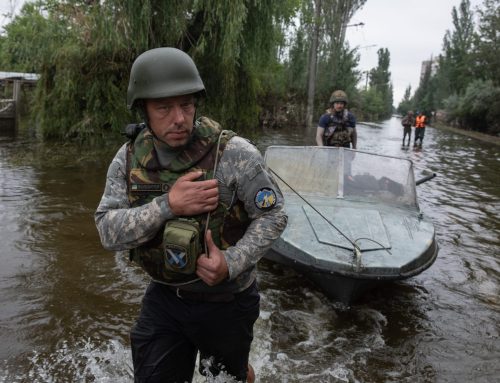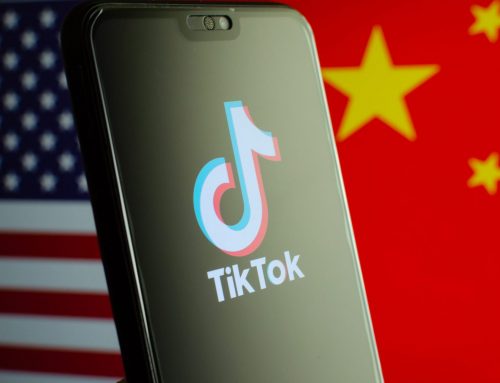Russia Toplines
The leading topic of the Russian media ecosystem last week was once again the coronavirus. The virus has now occupied this position for 14 straight weeks. Basic news updates on the pandemic accounted for much of this coverage. Some content addressed anti-lockdown protests around the world, coming down on both sides of the issue—RT in particular focused on the perspectives of the protestors themselves. In non-coronavirus output, articles on U.S.-Iran tensions saw significant engagement on websites, while the steady drip of updates related to WikiLeaks founder Julian Assange on RT YouTube channels continued.
China Toplines
Chinese state media outlets continue to focus on the coronavirus epidemic. As the war of words between China and the United States has escalated, Chinese state media has focused increasingly on deflecting blame onto the United States and highlighting what it characterizes as the United States’s failure to respond effectively to the virus. This included messaging contrasting China’s embrace of a multilateral, WHO-centered approach with what state media characterized as U.S. attacks on the organization and multilateralism itself. Many tweets and state media pieces also spotlighted pain, dissatisfaction, and dissent in the United States caused by the epidemic, with a particular focus on protests over coronavirus lockdowns.
Russia
Russian state-funded media and government and diplomatic corps accounts:
Top 10 Hashtags — April 18-24:
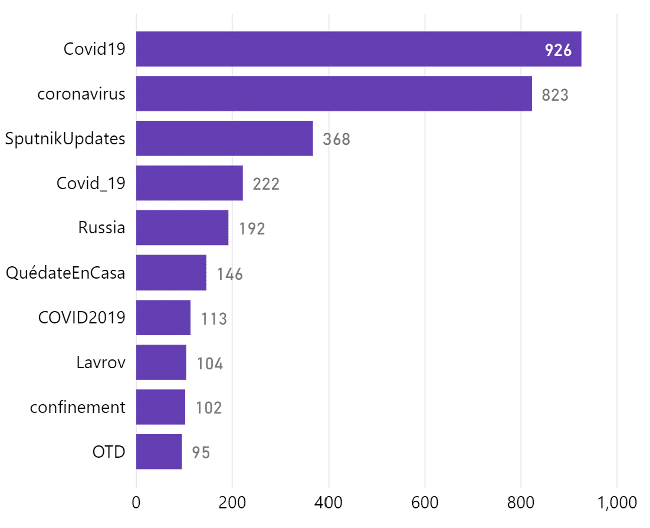
Between April 18 and 24, the Hamilton dashboard collected about 14,000 tweets from Russian state-funded media and government Twitter accounts (figures as of 3pm April 24). A little over 4,300 tweets mentioned “virus,” “covid,” or both, marking a slight decline in the percentage of output from the previous week. Six of the top ten hashtags directly referenced the pandemic (including #QuédateEnCasa, Spanish for “stay at home,” and #confinement, French for “quarantine”), and the top two hashtags, #Covid19 and #coronavirus, saw far more uses than the next most used hashtag.
The three accounts that tend to receive very high engagement regardless of topic (@actualidadrt, @rtultimahora, and @sputnik_tr) posted all but one of the top overall tweets by engagement metrics, mainly providing basic news about the coronavirus and oil prices. The only remaining top overall tweet came from the new Russian ambassador to Venezuela, Sergei Melik-Bagdasarov, who began his post earlier this year. He highlighted the Russia-Venezuela bilateral relationship and called for international coordination to fight the coronavirus:

The top overall tweets from accounts—besides the three high engagement accounts—included four related to anti-lockdown protests or lockdown violations in the West. These posts included one from Redfish, a Berlin-based media company supported by the Kremlin, featuring a video compilation of clips from anti-lockdown protests across the United States and asked if the people shown were a “capitalist death cult.” RT seemed to focus on the sentiments of the protestors, while left-leaning Redfish took the opportunity to make systemic critiques of problems in the United States, characterizing the protestors as the embodiment of these issues. RT also covered reports of overzealous police responses in Europe:




Around 270 tweets directly mentioned protests, demonstrations, or rallies during this period (note that this tally excludes tweets that reference such events more obliquely or through images, and it may include some false positives like diplomatic protests). Examples included:


(The above tweet sought to draw attention to police responses to the listed protests.)

Websites
Russian government-funded websites:
Out of about 1,300 articles from Russian government-funded news websites collected on the dashboard last week, a little over 700 mentioned “virus” in the first 200 words. Continuing a trend, much of this content consisted of basic news updates. However, two of the top four stories based on Facebook shares covered heightened tensions between the United States and Iran in the Persian Gulf, including the top story:
“Trump instructs US Navy to shoot down and destroy all Iranian gunboats that ‘harass our ships at sea,’” RT, April 22, 2020.
“President Donald Trump has ordered the US Navy to “shoot down and destroy” Iranian gunboats, should they harass American vessels at sea. His declaration comes after a confrontation in the Persian Gulf.”
“US warships will be DESTROYED if they threaten ANY Iranian vessel – Iran’s Revolutionary Guards chief,” RT, April 23, 2020.
“Iran will not hesitate to retaliate against the US Navy if it attacks any Iranian vessel, Tehran’s elite Islamic Revolutionary Guard Corps (IRGC) commander has warned, responding to a similar threat by Trump . . . Last week, the US Navy accused Iranian warships of maneuvering in a “dangerous and provocative” manner near its own vessels in the Persian Gulf. Tehran rejected these claims, saying its patrol boats had to intercept and monitor the American ships because they were violating maritime protocols while navigating in the area.”
Other top stories and opinion pieces highlighted studies questioning the timeline and mortality rate of the coronavirus pandemic and anti-lockdown protests in the United States, and they criticized U.S. officials’ “legitimiz[ation of] Covid-19’s China lab origins conspiracy theory.” RT appeared to focus heavily on the protestors’ anger:
“Covid-19 much more widespread than thought, and NO MORE DEADLY THAN FLU, new Stanford study suggests,” RT, April 17, 2020.
“A study out of Stanford University tested California residents and found that the Covid-19 infection rate is likely far higher than has been reported, but the virus could also be far less lethal than commonly believed.”
“Neither ‘lab’ nor ‘wet market’? Covid-19 outbreak started months EARLIER and NOT in Wuhan, ongoing Cambridge study indicates,” RT, April 18, 2020.
“The novel coronavirus may have first passed to humans somewhere in southern China months before the outbreak in the city of Wuhan, a new study found, cutting against widely held theories about the origins of the pandemic.”
“‘Fire Fauci, let us work’: No social distancing as Alex Jones joins hundreds in rally against Covid-19 lockdown measures in Texas,” RT, April 18, 2020.
“Texans flocked to the state’s Capitol in Austin to protest Covid-19 lockdown measures, refusing to practice social distancing and cheering for Dr. Anthony Fauci to be fired by President Donald Trump.
In attendance at Saturday’s ‘You Can’t Close America’ Rally were InfoWars founder Alex Jones and host Owen Shroyer, who led the crowd of some 200 people in chants against the mainstream media and officials like Fauci. Shroyer, who referred to the doctor as “fascist Fauci,” asked the crowd: “Do you think Anthony Fauci should be fired?”, before leading them in chants of “Fire Fauci.””
“As the Trump administration legitimizes Covid-19’s ‘China lab’ origins conspiracy theory, remember Iraqi ‘WMD,’” Op-ed, RT, April 17, 2020.
“By publicly entertaining theories linking the Covid-19 virus to Chinese research laboratories, US President Donald Trump and his administration are setting China up as the witch in a new political witch hunt.”
About 30 articles covered protests around the world related to the coronavirus, primarily anti-lockdown demonstrations. Notable articles on U.S. protests besides the one above included:
“‘Open the economy – I need to feed my family!’ Will lockdown fatigue spiral into destructive mass protests?” Op-ed, RT, April 22, 2020.
“As the world races against time to beat Covid-19, many feel the lockdown has been unfair and over-the-top. Now, anger and frustration threatens to snowball into something that makes a pandemic look like a picnic by comparison. For many Westerners, many of whom are living paycheck to paycheck, the ‘shelter-at-home’ order in response to the coronavirus feels like a death sentence, especially if accompanied by the loss of a job. Now, many people, despite lockdown orders, are beginning to vent their anger on the streets.”
“US Anti-Quarantine Protests Win Billionaire Support as Bludgeon Against the Left – Professor,” Opinion, Sputnik News, April 21, 2020.
“Protests last week in several US states against what residents claimed to be draconian measures imposed by Democratic governors to curb the spread of COVID-19 have gotten support from high places as a right-wing weapon against a perceived threat of left-wing ideas, political science professor Jodi Dean told Sputnik.”
“Facebook CENSORS anti-quarantine protests in US as ‘harmful misinformation,’” RT, April 20, 2020.
“Americans protesting their states’ coronavirus lockdown measures won’t be able to organize protests on Facebook any longer, after the Silicon Valley firm declared them ‘harmful misinformation.’”
Sputnik also put out several radio shows that commented on the U.S. protests, with titles such as “Trump Eggs on Anti-Government Protests” and “As Leftists Uplift Essential Workers, the Right Works to Endanger Them,” both from April 20.
In reporting on other countries’ protests, the most noteworthy articles included one detailing what was described as a “strong police response” to protests in Berlin and, a bit unusually, two on protests in Russia:
“WATCH Berlin police forcefully disperse unsanctioned protest against coronavirus lockdown,” RT, April 18, 2020.
“Hundreds of activists gathered in central Berlin, defying government Covid-19 lockdown measures and arguing the state is heading for “authoritarian rule.” The gathering was met with a strong police response.”
“Russians ‘take to the streets’ ONLINE in protest over coronavirus measures,” Russia Beyond, April 22, 2020.
“The recent ban on public gatherings, social distancing and self-isolation rules in Russia has people protesting by way of Yandex’s satellite navigation app. Modern problems require modern solutions, they say. At least, that’s what some people across Russia decided having had enough of the government’s self-isolation regime. The citizens of more than 10 Russian cities took to ‘Yandex.Navigator’ and ‘Yandex.Maps’ – the Russian search giant’s GPS apps – to create huge chat sessions and mark every protester on the map, together with a small comment.”
“Protesters gather in Russia’s N. Ossetia-Alania to demand cancellation of self-isolation rules,” RT, April 20, 2020.
“Hundreds of protesters – most of them unmasked – gathered on Monday in Vladikavkaz, the capital of the southern Russian Republic of North Ossetia-Alania, to demand the cancellation of the self-isolation regime. The unauthorized meeting took place near the building of the local government despite restrictions, which will last till April 30.”
Broadcasts
Russian state-owned media:
Almost three-quarters of the videos collected from Russian state-owned media on YouTube last week addressed some aspect of the pandemic, with RT’s UK channel in particular reporting on various criticisms of the UK government’s response. Examples included:
“Are Johnson’s Cobra absences the root of UK’s unpreparedness?” RT UK, April 20, 2020.
“Boris Johnson missed five Cobra meetings in the run up to the UK’s coronavirus crisis. What vital decisions were glossed over by his absence? Columnist Andre Walker explains if the UK’s poor response and Johnson’s absence have any correlation.”
“State school kids lose out on education in lockdown,” RT UK, April 21, 2020.
“It seems that EVEN lockdown is divided by the haves and have-nots! Only 23% of state pupils have access to learning resources online compared to over double that for those in private school.”
Only one collected broadcast covered anti-lockdown protests in the United States, while a notable non-coronavirus video described censorship claims related to the U.S. presidential race:
“Who are the protesters calling for lockdowns to end?” RT America, April 20, 2020.
“While President Trump has launched his initiative to “re-open America,” people across the United States protested in the streets.”
“Green Party presidential candidate accuses Twitter of censoring campaign,” RT America, April 21, 2020.
“Green party presidential candidate Howie Hawkins recently had his campaign Twitter account totally expelled, along with a number of alternative voices in the media or social activists, a growing trend that seems to be clamping down on free-speech as we draw closer to the elections in November. Howie Hawkins himself joins In Question to discuss.”
RT channels once again covered developments related to the saga of WikiLeaks founder Julian Assange last week on allegations that a Spanish security firm illegally spied on Assange while he lived in the Ecuadorian embassy in London. Videos on this update sharply criticized the United States. For example:
“George Galloway on Julian Assange’s treatment by spanish[sic] security firm,” RT UK, April 23, 2020.
““It must represent the lowest form of spying that the U.S. has ever been involved in.” George Galloway tells Manila Chan, as Spanish firm accused of secretly obtaining Julian Assange’s son’s dirty diapers and “intimate photos”, court documents show.””
“Security firm spied on Assange’s fiancée and children in embassy – Spanish court,” RT America, April 22, 2020.
“37-year-old lawyer Stella Morris, the fiancée of WikiLeaks co-founder and journalist Julian Assange, revealed her identity just days before a Spanish court was expected to do so in the case against Spanish security firm UC Global.”
China
Chinese state-funded media and government and diplomatic corps accounts:
Top 10 Hashtags — April 18-24:
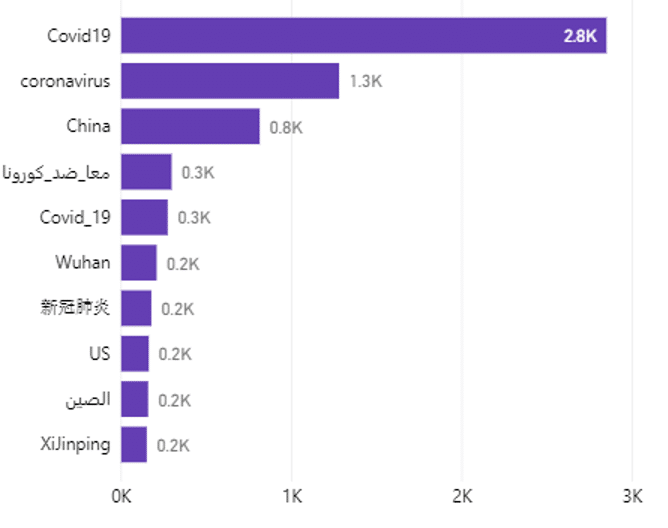
The Hamilton dashboard collected about 14,000 tweets from Chinese state-funded media and government Twitter accounts the week of April 18-24 (figures as of 3pm April 24). The coronavirus continued to dominate all top hashtags; every top hashtag was either directly related to the virus or promoted epidemic-related coverage (“XiJinping”, for example, covered the Chinese Communist Party leader’s virus-related messaging).
Many of the most engaged-with tweets for the past week sought to cast the United States’ coronavirus response in a negative light.


(Hu Xijin is the editor-in-chief of the state-run tabloid Global Times, and is often an acerbic critic of the United States.)
Two of China’s top foreign ministry spokespeople, Zhao Lijian and Chunying Hua, also retweeted an article from U.S. outlet The GrayZone calling the theory of coronavirus escaping from a Wuhan research lab the “Trump administration’s Iraqi WMD [moment],” a nearly identical take to the RT op-ed highlighted in the above Russia report.

Lijian amplifying a tweet criticizing U.S. officials for pushing a “conspiracy theory” about the Coronavirus escaping from a Chinese research lab is deeply ironic, given that Lijian previously tweeted a parallel theory that claimed the Coronavirus originated in a U.S. research lab.

Other top tweets focused on other countries praising China for its assistance during the epidemic, including one highlighting praise from Vladimir Putin. Although the tweets frame this assistance as a gift, it is typically masks purchased on a commercial basis.


One important change from previous weeks was the appearance of Xi Jinping in the top hashtags. The Chinese Communist Party’s supreme leader made a public inspection tour of poverty alleviation work in Shaanxi Province on Tuesday. Significantly, he was not wearing a protective facemask, nor were any of the people in his staged photo shoots. This is a marked departure from Xi’s relatively few public appearances since the beginning of the coronavirus outbreak.
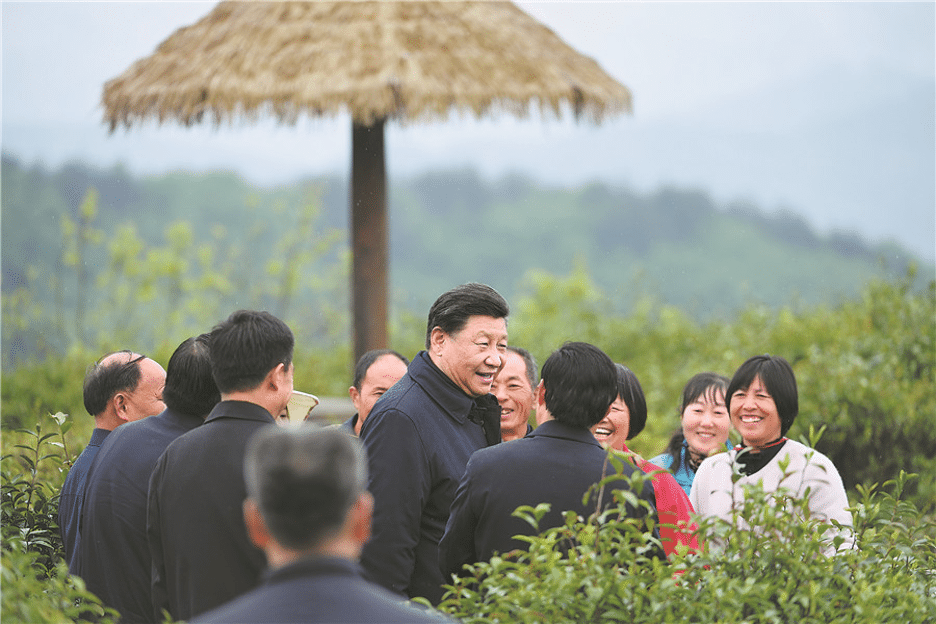
State media outlets highlighted Xi’s visit to foreign audiences, as an attempt to signal that China’s economy is recovering from the coronavirus, that the party remains stable and committed to its policy goals, and that Xi himself remains well-liked and in control.
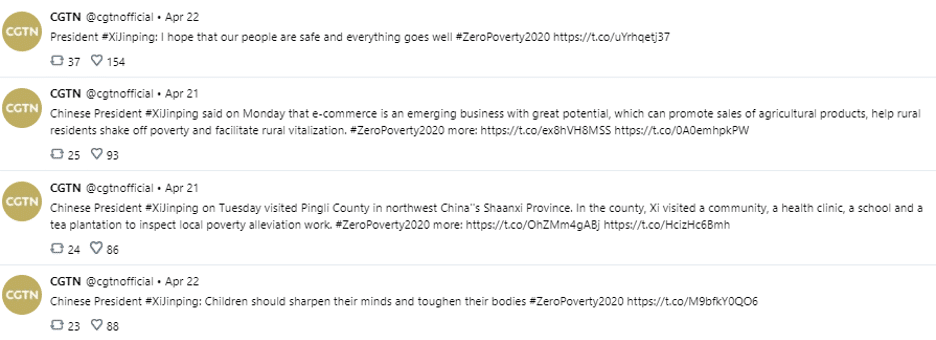
Looking below the very top tweets, another consistent theme was defense of the WHO and its director, Dr. Tedros Adhanom Ghebreyesus, often linking this support with China’s defense of multilateralism and presenting a common front against the coronavirus.



In one last point of note, although the top hashtags were all coronavirus-related, the three most retweeted tweets for the past week were not about the virus, but about a Korean pop band. Tweeting out “amusing” content to drive engagement is a tactic frequently employed by China’s state media accounts.



Websites
Chinese government-funded websites:
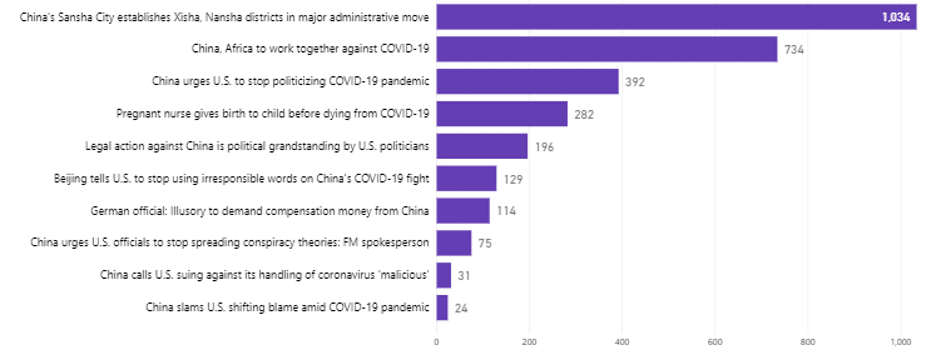
The most shared story by state media on Facebook concerned the establishment of new administrative districts on China’s islands in the South China Sea. As is common with controversial subjects involving sovereignty in Chinese state media, the article adopts a neutral, technocratic tone, grounding the report in the details of the move, and leaving out entirely the controversy China’s construction of the islands has caused with nearby countries such as Vietnam and the Philippines.
“China’s Sansha City establishes Xisha, Nansha districts in major administrative move,” CGTN, April 18, 2020.
“The whole city covers nearly two million square kilometers, but including only around 20 square kilometers of land area now. Sansha has only some 1,800 permanent residents, according to its government introduction, making it the very prefecture-level city with the most southern location, the largest area, the smallest land area and the smallest population in China.”
Other popular stories addressed attempts by US state-level officials to bring suit against China for damage caused by the coronavirus. One widely shared piece on the subject was by state media columnist Tom Fowdy. Its argument hews closely to sentiments expressed by left-leaning political commentators in the United States that conservative politicians are attempting to attack China as a way of distracting from shortcomings in addressing the coronavirus.
“Legal action against China is political grandstanding by US politicians,” CGTN, April 22, 2020.
“Given this, like what we are seeing in so many other instances in the U.S., the state administration is weaponizing anti-China populism in order to capitalize on the anger and disillusionment of its own population amid the COVID-19 outbreak. It promises absolutely no results whatsoever, yet it acts as an opportunistic venting point for nationalist indignation.”
Other widely shared articles on the same theme are below:
“China urges U.S. to stop politicizing COVID-19 pandemic,” Xinhua, April 18, 2020.
“Smearing China cannot help the U.S. side to cover up facts and shifting blame cannot drive the virus away, said a Chinese Foreign Ministry spokesman after U.S. Defense Secretary said that China ‘have been misleading the United States and opaque’.”
“China calls U.S. suing against its handling of coronavirus ‘malicious,’” CGTN, April 22, 2020.
“China’s Foreign Ministry on Wednesday slammed the accusation of the U.S. that China should be responsible for the coronavirus pandemic that has affected over 2.56 million people in the world, saying such allegation against the country is groundless and lacks legal basis.”
Other top stories at different points during the week concerned the sharp downturn in oil prices mid-week. One framed it as “U.S.” oil prices, while another addressed—in somewhat technical language—the news that a trading failure by Bank of China had resulted in huge losses for retail customers who had purchased one of its investing instruments.
“U.S. oil price turns negative for first time in history,” Xinhua, April 21, 2020.
“U.S. oil prices crashed to the negative territory for the first time in history on Monday, fueled by pandemic-related demand shock and oversupply fears.”
“Bank of China: settlement price refers to the futures exchange,” CGTN, April 22, 2020.
“[Bank of China] on Tuesday suspended trading in both of its U.S. crude oil contract products for one day. Some investors blamed the bank for setting their price on the lowest point, but not as the trading closed on 10 p.m. when the price was still above the 0 U.S. dollars a barrel level. Investors believed it was the bank’s fault that caused them to have to pay three times their margin.”
Broadcasts
Chinese state-owned media:
Coronavirus continues to dominate coverage on China’s state-media broadcasters. As in the previous update, many pieces continued to spotlight pain, dissatisfaction, and dissent in the United States caused by the epidemic, including two pieces in an ongoing series on “essential” people forced to work amid the pandemic, which would not seem out of place as a video feature by The New York Times or The Atlantic. A piece on the effect of the “digital divide” on teaching during the epidemic struck a similar tone.
“The Essential People: Risking their lives to deliver,” CGTN America, April 22, 2020.
“We hear so much now about the so-called ‘essential workers’ we rely on during this pandemic. The doctors, nurses, first responders, grocery store clerks and sanitation workers. There’s another group of unsung heroes on the job who’ve gotten less attention, while performing a function every bit as vital. Truck drivers.”
“The Essential People: U.S. migrant farmers feel expendable in COVID-19,” CGTN America, April 20, 2020.
“Essential, invisible, or expendable? Today we launch our series on the #essential people who continue to work during the #coronavirus pandemic. We talked to undocumented migrant farmers in California who are risking their lives to bring produce to U.S. consumers.”
“Digital divide in U.S. hampers online teaching,” CGTN America, April 21, 2020.
“Schools in the U.S. are closed to stop the spread of COVID-19. Millions of American kids are learning online instead. But more than 20 million people in the U.S. don’t have any internet access. Only two-thirds of Americans in rural areas have a broadband connection. And it’s that “digital divide” that has educators and parents worried.”
“Staying safe while trying to avoid economic collapse in the gulf shores of America,” CGTN America, April 21, 2020.
“A battle is brewing along coastal communities in the United States. Alabama is joining the fight, calling on the state’s governor to re-open beaches during the pandemic. But state leaders have to weigh the ills of a killer virus – over the potential disaster of economic collapse”
“U.S. food banks stretched to the limit as unemployment soars,” CGTN America, April 20, 2020.
“The financial effect of the virus has been felt across small towns in America. Aside from government subsidies, people have been turning to food banks. And the pantries there are being stretched to the limit. CGTN’s Sean Callebs reports from Morehead City, North Carolina.”
“More protests in several U.S. states over stay-at-home orders,” CGTN America, April 19, 2020.
“Various U.S. states make plans to ease restrictions, despite the advice of heath officials in the Trump Administration. This comes as the number of confirmed cases in the United States jumps nearly 20,000 in one day and the death toll tops 38,000.”
In the past two days, CGTN has also begun to roll out its video coverage of Xi’s Shaanxi visit. As with Twitter messaging, the videos portray Xi as firmly in command and encouraging a virus-battered nation towards optimism and a successful economic recovery. One piece highlighted the important role of state-owned enterprises in the recovery, which is consistent with Xi’s emphasis on a strong state sector throughout his rule.
“State-owned Enterprises Are Fresh, Major Forces for Work Resumption: Xi,” CCTV Video News Agency, April 23, 2020.
“Chinese President Xi Jinping on Wednesday stressed the important role of the state-owned enterprises in work resumption and production as the COVID-19 battle goes on across China.”
“Xi Encourages XJTU Teachers, Students to Carry Forward Selfless Dedication, Hardworking Spirit,” CCTV Video News Agency, April 23, 2020.
“Chinese President Xi Jinping encouraged teachers and students of the Xi’an Jiaotong University (XJTU) to carry forward the spirit of selfless dedication and hardworking on Wednesday.”
The views expressed in GMF publications and commentary are the views of the author alone.






